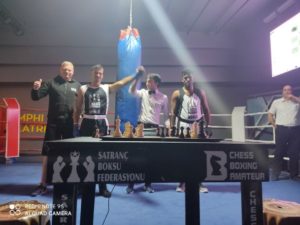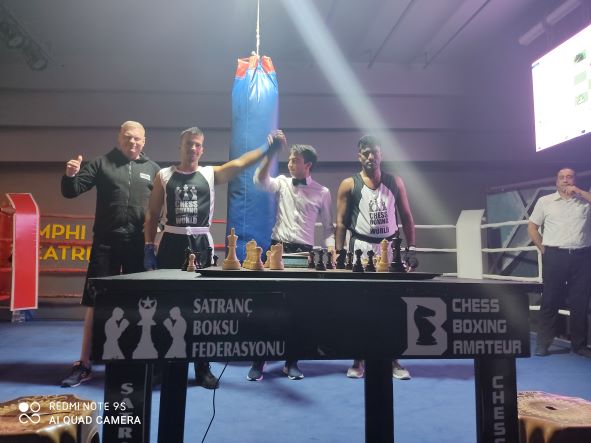Chessboxing-fit does not envisage a real fight in the ring but it is a competition that involves punching a boxing bag and playing a blitz chessgame. It can also be fought via video-call or similar: both athletes could be in different places.
The concept of chessboxing-fit was invented by Rishat Sayapov. The following are the regulations ideated by Rishat and improved and better developed on paper by Volfango Rizzi. Volfango Rizzi (together with Sergio Pagano) was instead the creator of Chessboxing Light (created in 2015) which is another form of chessboxing that widens the opportunity for participation; chessboxing light was also developed to (re)establish a balance between chess and boxing as chessboxing seems to favour chess.
A competition of chessboxing-fit:
1. Matches
are made between two athletes. Tournaments can be made were several athletes compete in different matches, in ko format, or pools, with Swiss pairings, and other systems of grouping and pairings.
A chessboxing-fit match consists of two or, when needed, three rounds which are disputed as follow:

1st round: boxing (punches to the boxing bag);
2nd round: a blitz chess game;
3rd round, when needed: boxing (punches to the boxing bag).
boxing round(s) 1 minute;
chess round 5 minutes;
Timeouts 1 minute between one round and the other.
3. Equipment needed
4. Rules of the boxing round(s)
– blows on the boxing bag should be done with boxing technique, which the judge assesses;
– the judge counts the strikes and applies the coefficient (1; 0.75; 0.5; or 0.25) depending on the boxing technique demonstrated by the participant;
5. Rules of the chess round
– Early win:
the whole fight is won by the fighter who wins in the chess round by checkmating the opponent, or when is opponent loses on time or when one withdraws from the fight.
– Winning on points:
the total number of strikes counted by the referee(s), in rounds 1 and 3, are multiplied by the coefficients awarded to each fighter. The athlete with the highest points wins.
If the final score is equal it is a draw. If a winner is needed – because of a tournament format or because there is a title at stake – the athlete with the black pieces is declared the winner.
Children (male, female) below age 10;
Juniors (male, female) 14-17;
Adults (men, women) 18-49;
Veterans (men, women) 50-59
The RS (Rapid & Smart) coefficient is used to balance the number of strikes with the technical and tactical boxing component of chessbox-fit.The judge(s) decides on the “RS” coefficient for what one athlete has shown. The RS is then multiplied by the number of blows inflicted on the bag in the round.When selecting the “RS” coefficient, four technical components are taken into account:
- Most of punches given in conformity with classical boxing technique: straigh punches (do not count: hitting with an open glove, with the wrist, with the backhand, or with the side of the hand);
- Protective actions: blocking, parrying, rolling, slipping, defensive footwork, and countering;
- Blows performed with displacement of the body’s center of gravity by means of pushing with one or two legs, with pelvis rotation and/or back rotation;
- Technical actions: footwork, combinations of jabs, crosses, hooks, and uppercuts.
| Coefficient | Technique |
| 1 | All four technical components are present |
| 0,75 | Absence one of the components |
| 0,5 | Absence of two components |
| 0,25 | Most of blows in no compliance with boxing technique |






